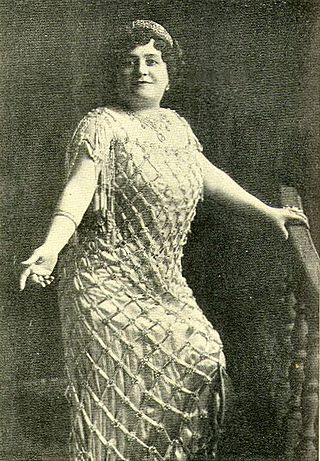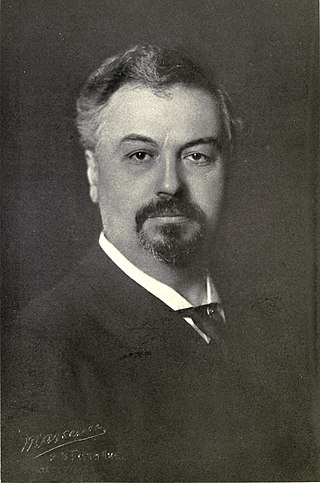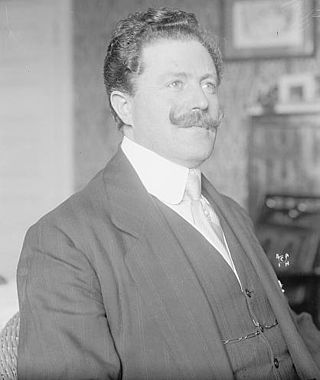
Mary Garden was a Scottish-American operatic lyric soprano, then mezzosoprano with a substantial career in France and America in the first third of the 20th century. She spent the latter part of her childhood and youth in the United States and eventually became an American citizen, although she lived in France for many years and eventually retired to Scotland, where she spent the last 30 years of her life and died.

Lyric Opera of Chicago is one of the leading opera companies in the United States. It was founded in Chicago in 1954, under the name 'Lyric Theatre of Chicago' by Carol Fox, Nicola Rescigno and Lawrence Kelly, with a season that included Maria Callas's American debut in Norma. The company was re-organized by Fox in 1956 under its present name and, after her 1981 departure, it has continued to be of one of the major opera companies in the United States. The Lyric is housed in a theater and related spaces in the Civic Opera Building. These spaces are now owned by the Lyric.

Luisa Tetrazzini was an Italian dramatic coloratura soprano of great international fame. Tetrazzini "had a scintillating voice with a brilliant timbre and a range and agility well beyond the norm...". She enjoyed a highly successful operatic and concert career in Europe and America from the 1890s through to the 1920s. Her voice lives on in recordings made from 1904–1920. She wrote a memoir, My Life of Song, in 1921 and a treatise, How to Sing, in 1923. After retirement, she taught voice in her homes in Milan and Rome until her death.

Oscar Hammerstein I was a German-born businessman, theater impresario, and composer in New York City. His passion for opera led him to open several opera houses, and he rekindled opera's popularity in America. He was the grandfather of American playwright/lyricist Oscar Hammerstein II and the father of theater manager William Hammerstein and American producer Arthur Hammerstein.

Arthur Hammerstein was an American songwriter, dramatist, playwright and theater manager.

Ellen Beach Yaw was an American coloratura soprano, best known for her concert career and extraordinary vocal range, and for originating the title role in Arthur Sullivan's comic opera The Rose of Persia (1899).

Orville Harrold was an American operatic tenor and musical theatre actor. He began his career in 1906 as a performer in operettas in New York City, and was also seen during his early career in cabaret, musical theatre, and vaudeville performances. With the aid of Oscar Hammerstein I, he branched out into opera in 1910 as a leading tenor with Hammerstein's opera houses in New York City and Philadelphia. While his career from this point on primarily consisted of opera performances, he periodically returned to operetta and musical theatre throughout his career. He notably created the role of Captain Dick Warrington in the world premiere of Victor Herbert's operetta Naughty Marietta in November 1910.

The Manhattan Opera Company was an opera company based in New York City. Active from 1906 until 1910, it was founded by Oscar Hammerstein I.

Cleofonte Campanini was an Italian conductor. His brother was the tenor Italo Campanini.
Gaetano Merola was an Italian conductor, pianist and founder of the San Francisco Opera.
The Civic Opera Company (1922–1931) was a Chicago company that produced seven seasons of grand opera in the Auditorium Theatre from 1922 to 1928, and three seasons at its own Civic Opera House from 1929 to 1931 before falling victim to financial difficulties brought on in part by the Great Depression. The company consisted largely of the remnants of the Chicago Opera Association, a company that produced seven seasons of grand opera in the Auditorium Theatre from 1915 until its bankruptcy in 1921.
The Chicago City Opera Company was a grand opera company in Chicago, organized from the remaining assets of the bankrupt Chicago Grand Opera Company, that produced four seasons of opera at the Civic Opera House from 1935 to 1939 before it too succumbed to financial difficulties. It was succeeded by the Chicago Opera Company.

Minnie Egener (1881–1938) was an American operatic mezzo-soprano.

The Metropolitan Opera House is a historic opera house located in Philadelphia, Pennsylvania. It has been used for many different purposes over its history. Now known as The Met, the theatre reopened in December 2018, after a complete renovation, as a concert venue. It is managed by Live Nation Philadelphia.
Walter Cassel was an American operatic baritone and actor. He began his career singing on the radio during the mid-1930s and appeared in a couple of Hollywood musical films in the late 1930s. He made his first stage appearances in a handful of Broadway productions during the late 1930s and early 1940s. He began his opera career at the Metropolitan Opera in 1942, and went on to have a long and fruitful association with that house that lasted until his retirement from the stage in 1974. In addition to working with the Met, Cassel was also a regular performer with the New York City Opera between 1948 and 1954 and worked frequently as a freelance artist with important opera companies on the international stage as well as in the United States.

The Boston Opera Company (BOC) was an American opera company located in Boston, Massachusetts, that was active from 1909 to 1915.

Nicola Zerola was an Italian operatic tenor who had an active international career from 1898-1928. He began his career in his native country, but was soon heard in concerts and operas internationally during the first years of the 20th century. In 1908 he relocated to the United States where he was active with important opera companies in New York, Chicago, and Philadelphia up into the late 1920s. Between 1909 and 1911 he recorded 13 issued sides for the Victor Talking Machine Company at their Camden, New Jersey studios. He also made 11 solo recordings and one duet for the Gramophone and Typewriter Company in England in 1910-1911.

Alice Zeppilli was a French operatic soprano of Italian heritage who had an active international singing career from 1901 to 1930. The pinnacle of her career was in the United States where she enjoyed great popularity between 1906 and 1914; particularly in the cities of Chicago, New York, and Philadelphia. She was popular in Monte Carlo where she performed frequently from 1904–19 and later worked as a singing teacher after her retirement from the stage. She made only one recording, a phonograph cylinder for Columbia Records consisting of the Gavotte from Jules Massenet's Manon and Olympia's Doll Aria from Jacques Offenbach's The Tales of Hoffmann.















